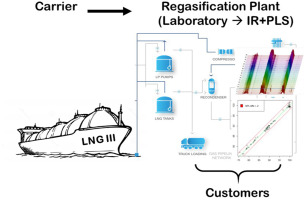| Title: | Modeling the natural gas knocking behaviour using gas-phase infrared spectra and multivariate calibration |
| Authors: | Santiago Ponte, Jose Manuel Andrade, Cristina Vázquez, Borja Ferreiro, Carlos Cobas, Andrés Pérez, María Rey, Carlos Vales, Jose Pellitero, Blanca Santacruz, Soledad Muniategui, Purificación López-Mahía, Bo Shu, Helga Bettin, Daniela Klaus, Bert Anders, Marius Betz, Ulf Kühne, Christian Meier, Peter Eilts |
| Date: | June 2021 |
| Reference: | Journal of Natural Gas Science and Engineering Volume 90, June 2021, 103944 |
| DOI: | https://doi.org/10.1016/j.jngse.2021.103944 |
| Download link: | https://www.sciencedirect.com/science/article/pii/S1875510021001517?via%3Dihub |
ABSTRACT
To assess the knocking properties of natural gas (NG) when it is used as fuel for vehicles is vital to optimize the design and functioning of their motors. Analytical efforts in this field are needed as the engines used to define it empirically are not available anymore, and existent mathematical algorithms yield different accuracy. The hybridization of gas-phase infrared spectrometry and partial least squares multivariate regression is presented first time to address the determination of the methane number (MN) of NG samples. It circumvents the need for the previous knowledge of the NG composition required to apply dedicated equations.
The use of true NG samples to develop the models is also quite new in the field. Proof-of-concept studies were made with synthetic spectra and, then, a collection of liquefied NG samples for which MN values were computed by the National Physics Laboratory algorithm (NPL) from their sample composition were used to develop operative models. Additional validation was made with a collection of synthetic standard mixtures prepared for two European projects (EMRP LNG II and EMPIR LNG III) whose service methane numbers (SMN) were measured with an engine. The FTIR-PLS approach yielded statistically unbiased predictions with average standard errors around 0.4% MN when compared to the NPL-MN and SMN values, and standard deviations of the means ca. 1% MN. The approach is fast, cost effective as it involves standard instrumentation, and can be considered compliant with the green chemistry principles.



